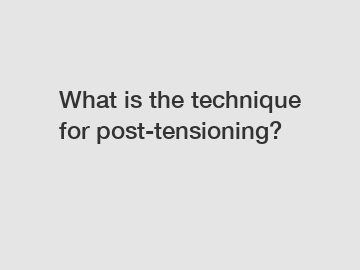What is the technique for post-tensioning?
Post-tensioning is a technique that is commonly used in the construction industry to strengthen concrete structures and make them more resistant to various forces such as bending, shear, and compression. It is a method that involves applying tensioning forces to the concrete after it has cured, which helps to counteract the forces that the structure will experience during its service life.
The technique of post-tensioning involves the use of high-strength steel cables or bars that are inserted into ducts that have been placed within the concrete formwork before the concrete is poured. Once the concrete has set and achieved sufficient strength, the tendons are tensioned using hydraulic jacks, which results in a compressive force being applied to the concrete. This compression helps to counteract the tensile forces that the structure will experience, which can be particularly beneficial in situations where the structure is subject to heavy loads or seismic activity.
There are two main methods of post-tensioning that are commonly used in construction: bonded post-tensioning and unbonded post-tensioning. In bonded post-tensioning, the tendons are grouted after they have been tensioned, which helps to transfer the forces from the tendons to the surrounding concrete. This method is often used in applications where corrosion protection is a concern, as the grout helps to protect the tendons from exposure to moisture and other environmental factors.

On the other hand, in unbonded post-tensioning, the tendons are not grouted, which allows them to move freely within the ducts. This method is often used in situations where the tendons need to be able to move to accommodate thermal expansion and contraction, or where the tendons are subject to higher stresses that could cause them to break if they were bonded to the concrete.
In both bonded and unbonded post-tensioning, the tendons are typically anchored at the ends of the structure using specialized anchorages that are designed to transfer the tensioning forces to the concrete. These anchorages are critical components of the post-tensioning system, as they must be able to withstand the forces that are applied to them without failing.
The process of post-tensioning requires a high degree of expertise and precision, as any errors in the placement or tensioning of the tendons can lead to structural problems or even failure. It is essential that the design and installation of post-tensioning systems are carried out by qualified engineers and contractors who have experience in the technique.
One of the key benefits of post-tensioning is that it allows for longer clear spans and thinner concrete sections than traditional reinforcement methods, which can result in cost savings and more efficient use of materials. Post-tensioned structures are also typically more durable and resistant to cracking, which can help to extend their service life and reduce maintenance costs over time.
In addition to its structural benefits, post-tensioning can also be used to create more aesthetically pleasing architectural designs, as the technique allows for the creation of unique shapes and curves that would be difficult or impossible to achieve with traditional reinforcement methods. This versatility and flexibility make post-tensioning an attractive option for a wide range of construction projects, from bridges and high-rise buildings to parking structures and residential developments.
In conclusion, post-tensioning is a versatile and effective technique for strengthening concrete structures and improving their performance under various loads and conditions. By understanding the different methods of post-tensioning and working with experienced professionals, builders and developers can take advantage of the many benefits that this technique has to offer, from cost savings and durability to design flexibility and aesthetic appeal.
If you want to learn more, please visit our website post tensioning system solutions, post tensioning wedge, post tension components.
Previous: Why do we use post tension slab?
Next: What are the top advantages of using Precision CNC milling services for finalizing a B2B purchase?
If you are interested in sending in a Guest Blogger Submission,welcome to write for us!




Comments
0